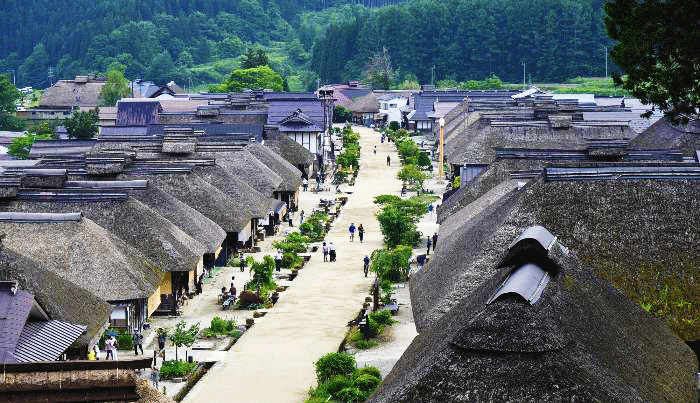Shiobara Onsen (Hot Spring)
- Traditional Hot Spring along beautiful valley.
(Written by Mr. Tokihisa Yokoi. Translation by Yoichi Miura)
Shiobara Onsen is located in the north of Tokyo and accessible by 1 hour 10 minutes train ride on
Tohoku Shinkansen bullet train, followed by 40 minutes road trip.
Along the Hoki-gawa valley, there are variety of inns (ryokan) ranging from a 400 year old
historical inn to a newly-renovated inn. Going through the built-up area of Shiobara Township, you
can reach Naka-Shiobara and Kami-Shiobara. If you turn left and follow steep and winding road
towards the mountain, you can reach Arayu* in ten minutes. Following steep road down from Arayu, you
can reach Motoyu**.
There are actually 11 hot spring areas/zones in Shiobara Onsen. Variety of hot springs are found in these areas; salty hot spring, carbon-hydrate hot spring, Sulphur-acid hot spring, Sulphur hot spring, acid hot spring and so on. You can choose an inn and hot spring as you like. Shiobara Onsen originated as hot spring lodge for rehabilitating/curing patients called Toojiba. There used to be people who stayed in Shiobara for their rehabilitation with their own cooking tools, according to some old people passed away recently. You will see rising steam clouds in central Arayu area. Rich hot spring fountains and surrounding natural beauty will surprise the people visiting Shiobara Onsen for the first time.


Taking the opportunity of visiting Shiobara Onsen, you should take a time to enjoy Hoki-gawa valley. Starting from Momiji-dani suspension bridge, you can visit either of three falls nearby; Ryuuka-no-taki, Kaiko-no-taki or Nuno-daki. The view of fresh green in spring or leaves turning colour in autumn is especially splendid.
After opening of Route 400 bypass along the Hoki-gawa valley, there becomes less traffic in the old Route 400, which was named as ‘Taisho Romantic Road’ and new pedestrian footpath was constructed by local people for visiting tourists to enjoy beauty of Hoki-gawa valley. There also is a new monument memorising great novelists and poets who visited and admired Shiobara. You will enjoy natural beauty of Shiobara by visiting the falls, monument and suspension bridges.
Botan flowers at Myounji Temple are ‘must’ to see in the season (=spring or May?).
Sakasasugi (Upside down cider?) at Shiobara Hachimangu Shrine is also a must. You can enjoy
Mizubasho (in English?) flowers in spring at Kami-Miyori Botanical Garden. The Kotarogafuchi gorge
is little known but interesting place. The gorge appears without expectation after following unpaved
road by car. There is a tea house offering kusa-dango (Japanese traditional sweet made from rice and
yomogi leaves) which is popular among visitors.
In summer time, you can enjoy field of lily flowers at Hunter Mountain ski resort located in the Myojin-dake Mountain just beyond Arayu. After going up by chair lift to middle of the mountain filled with lily flowers, you can walk down via comfortable footpath admiring the flowers. If you reach the summit of the mountain by gondola lift (or ropeway), you can enjoy view of Kanto Plain and mountains of Nikko Range during an hour's walk through footpath. Hunter Mountain is one of the leading ski resorts in Kanto District along with Oze-Iwakura Ski Resort in Gunma Prefecture and attracts many snow-sports enthusiasts with its good powder snow in winter season.
If you are fed up with traditional foods offered by the inn, you may visit an Italian restaurant in the middle of township. There also is a restaurant offering a bit peculiar food like stirred noodle in soup as well as several traditional soba (black wheat noodle) restaurants. Fishing pond across the Hoki-gawa from Shiobara Mono-gatari Pavillion offers salted grill of ayu or fried rainbow trout, particularly feels tasty in natural environment.

You can enjoy Shiobara in different way by visiting tourist spots nearby from there. Nasu Plateau or Nikko is not so far from Shiobara. Ouchijuku (village with old inns and houses) in Oku-Aizu is becoming famous recently and sometimes you may face traffic jam or difficulty in finding parking place. As it takes about two hours by car from Shiobara, you had better leave early and visit Ouchijuku and ‘Tou-no-hetsuri’ (narrow gorge with rocks).
You may enjoy luxury of visiting Nikko (world heritage) and stay overnight at Shiobara on first day
and visit Ouchijuku next day. There also are other interesting places than Ouchijuku such as
Hinoemata, mountainous village at the entrance of Oze National Park, or Yunishigawa Onsen, known as
refugee place of old Heike tribes in 12th century.
It will be easier to visit closer places like Otawara, where you can enjoy tasty beef, or Kurobane,
where famous Haiku-poet Matsuo Basho stayed in 18th century(?).
Shiobara is in such a nice location, you can make a variety of travels around there. Of course, you can stay a several days in Shiobara and enjoy hot springs as well as golf, fishing, skiing or hiking depending on the season of your visit.
- * Literally means ‘New Hot Spring’
- ** Literally means ‘Original or Source of Hot Spring’



